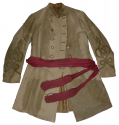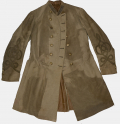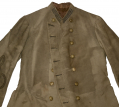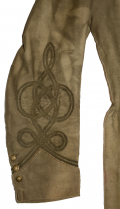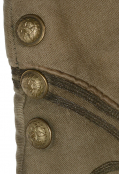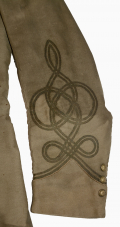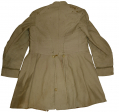site search
online catalog
CONFEDERATE CAVALRY CAPTAIN’S FROCK COAT OF CAPT. EDWARD BIRD, “EFFINGHAM HUSSARS,” 2nd BATTALION AND 5th REGIMENT GEORGIA CAVALRY
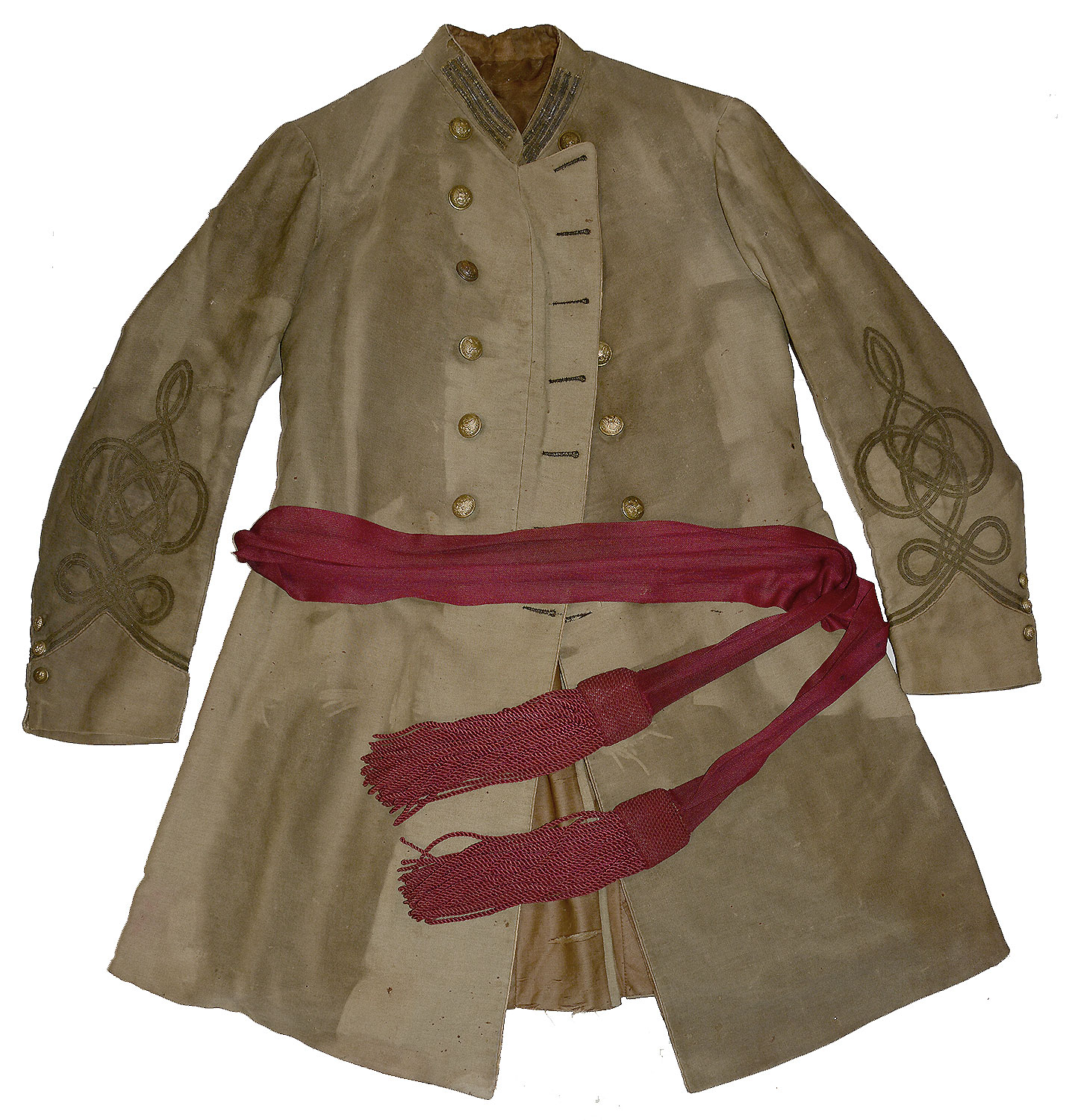
$60,000.00
Quantity Available: 1
Item Code: 1179-232
Shipping: Determined by Method & Location of buyer
To Order:
Call 717-334-0347,
Fax 717-334-5016, or E-mail
This rare, identified, Confederate cavalry captain’s frock coat belonged to an officer who served from 1861 though 1865, rising from Captain to Colonel, with extensive action especially in Wheeler’s cavalry corps fighting against Sherman in the Atlanta Campaign, March to the Sea, and Campaign of the Carolinas. The coat follows regulations in having three gold bars on each side of the collar, large gold braid galloons, or “Austrian knots,” on each sleeve, has a great light butternut tone, and is piped in yellow for the officer’s service in the cavalry, certainly the most romantic and popular branch of service in the Confederate army. It comes with 2005 letter of provenance from a very well-respected collector and dealer certifying his acquisition of it in the early 1980s from a small personal museum in Savannah (where it had also once been on display in a restaurant) and comes also with a full 2019 conservation by report of condition and treatment by Textile Preservation Associates when it entered the collections of the Texas Civil War Museum, all of which are available to interested parties.
The condition is very good, stable, and fully displayable, having been professionally cleaned and conserved. The standing collar has three gold braid bars sewn on each side, the longest, and lowest 3 1/3 inches long, with the gold slightly subdued by age. Similar braid is used to form tall galloons or “Austrian knots,” like the collar bars, regulation insignia of rank, which follow the edge of the 4-inch pointed cuffs then rise a further 9 inches in regulation loops. The braid is in excellent condition, slightly muted from age. The top edge of the collar, lapel of the coat, pointed cuffs and rear vent of the tails are all piped in yellow cord that has largely shifted to a soft, cream color. All buttons are US staff pattern, typical for an early war officer’s coat, with large buttons in two rows on the chest, and 4 at the rear waist and skirts, one of these is missing, and three small ones on each cuff.
The coat as whole is a light butternut color with slight darkening to the lower sleeves and left skirt. The fabric is solid and the coat presents very well, showing scattered moth damage more evident on the back, where there is a patch on the upper rear of the right shoulder, than on the front, where is more scattered on the sleeves. The interior is fully lined in brown cloth, quilted in the body at the sides and front. The lining of the back of the body showed wear and has been professionally stabilized with a fine, unobtrusive netting. The white sleeve linings are good. There is single interior pocket in the left breast and two pockets in the tails. The lining of the skirts shows wear, but is good.
(Included with the coat is an officer’s sash in very good condition, made of woven crimson silk, with flat, woven knots and tassels on each end. The condition is excellent. This was used in the Texas Civil War Museum for displaying the coat and is included with it, though its connection with Bird is uncertain.)
The coat was worn by Captain Edward Bird while Captain of Company A, 2nd Battalion Georgia cavalry, from 1861 through at least May 1862, when he received a commission as Lieutenant Colonel. Bird was born September 3, 1825, and was a lifelong resident of Effingham County, GA. He had married in 1850, was the father of four children, and at the beginning of the war operated a lumber and turpentine business, likely in addition to farming or plantation interests since the 1860 census shows him as farmer with real estate valued at $5,000 and personal estate of $8,845, wife and three children, ages 1, 3, and 5. The 1860 slave schedule shows “E & I Bird” in Effingham as owners with 23 people listed. This could refer to Edward and brothers John (born 1827) or James (born 1833.)
Bird’s service file indicates he enlisted Sept. 7, 1861, at Savannah for one year of service as captain of “Captain Bird’s Mounted Company,” also known as the “Effingham Hussars,” but he likely served earlier, with this date reflecting just the effective date of company’s ultimate organization as part of Georgia’s 2nd Battalion of cavalry. Some sources give him command of the company as early as April or July 1861 when the state was trying to raise two full regiments of cavalry, and credit the battalion with assembling first at Norfolk, Virginia, in 1861. As a militia company, the unit dated back to 1846, though antebellum references are sparse: 1859 notices refer to a target competition, though with a different captain. In February 1860 the “Effingham Troop” was part of an unsuccessful effort to form a cavalry regiment. Under Bird’s command the company shows up first as Company A, Squadron B, Georgia Cavalry, and then Company A, 2nd Battalion, Georgia Cavalry in Fall 1861 and early on the battalion largely saw service in patrols along the Georgia and South Carolina coast to guard against potential Union raids or landings.
The battalion was reorganized in May 1862, the usual time frame for re-enlisting troops for extended Confederate service, and at this point Bird was elected Lieutenant Colonel of the battalion, giving an upper date for his wear of this captain’s coat, with his commission and effective date of rank being variously given as May 17, 19, and 20, 1862. The battalion continued to serve as an independent unit stationed at Savannah, Isle of Hope, Skidaway Island, and at Charleston, SC, reportedly engaging in some light skirmishes. On January 20, 1863, however, the battalion was consolidated with the 1st Battalion Georgia Cavalry to form the 5th Regiment Georgia Cavalry, which served under that title to the end of the war.
The regiment continued its duty along the Georgia coast until August 1863, when they were sent to Charleston and placed under Beauregard’s command, reportedly fighting at Johns Island, Charleston, Green Pond and other locations, and in February 1864 moving to Florida, where they took part in the Battle of Olustee. In May 1864 they were ordered back to Savannah, but were diverted to join Wheeler’s command in the Army of Tennessee, taking part in the Atlanta Campaign. This more or less corresponded to Bird’s promotion to Colonel and command of the regiment from July 26, 1864, until the end of the war. He served continually with them in the field, records listing only a six-day leave of absence in late December 1864.
They saw significant action with Wheeler’s cavalry against Sherman in the Atlanta Campaign, at Savannah, and in the Campaign of the Carolinas. CWData lists 17 points at which they took casualties, but this is likely incomplete. Rigdon’s summary history of the regiment during this period credits them with participation in the fighting at Noonday Church, New Hope Church, Ezra Church, Kennesaw Mountain, Big Shanty, Marietta, Atlanta, Taylor’s Creek, Brown’s Mill, McCook’s Raid, and Bear Creek Station in the Atlanta Campaign. In opposing the March to the Sea they were at Griswoldville and Waynesboro. And in the Campaign of the Carolinas they were at Broxton’s Bridge, River’s Bridge, Aiken, Columbia, Bentonville, Monroe’s Crossroads, Averasborough, Smith’s Ferry, Black River, Bentonville, and Morrisville Station- their last engagement, in mid-April 1865. Bird finally surrendered with the regiment at Hillsboro, NC, April 26, 1865, with his own parole dating May 7.
Bird returned to his family and business in Effingham county after the war, being listed as engaged in timber cutting in 1870 and in farming in 1880. His attitude toward Reconstruction might be gained from his name in the 1867-69 “Qualified Voters and Reconstuction Oath Books,” where is name is crossed out and marked “Excluded” in red. This was likely lifted at some point: he served as a state representative 1880-1881. His house still stands in Guyton, where he died in April 1893.
This is a great example of a Confederate cavalry officer’s coat belonging to an officer with long and substantial service. [sr][ph:L]
~~~~~~~~~~~~~~~~~~~~~~~~~~~~~~~~~~~
THIS ITEM, AS WITH ALL OTHER ITEMS AVAILABLE ON OUR WEB SITE,
MAY BE PURCHASED THROUGH OUR LAYAWAY PROGRAM.
CLICK HERE FOR OUR POLICIES AND TERMS.
THANK YOU!
Inquire About CONFEDERATE CAVALRY CAPTAIN’S FROCK COAT OF CAPT. EDWARD BIRD, “EFFINGHAM HUSSARS,” 2nd BATTALION AND 5th REGIMENT GEORGIA CAVALRY
For inquiries, please email us at [email protected]
Most Popular
Historical Firearms Stolen From The National Civil War Museum In Harrisburg, Pa »
Theft From Gravesite Of Gen. John Reynolds »
Selection Of Unframed Prints By Don Troiani »
Fine Condition Brass Infantry Bugle Insignia »
British Imported, Confederate Used Bayonet »
Scarce New Model 1865 Sharps Still In Percussion Near Factory New »
featured item
“I LIKE YOUR STYLE” THE REGIMENTAL STANDARD OF THE 12th ILLINOIS CAVALRY: GAMBLE’S BRIGADE UNDER BUFORD ON JULY 1 AT GETTYSBURG
We can’t think of a more flamboyant, devil-may-care motto on a cavalry standard than this one, whose overtly casual nature no doubt intentionally contrasts with their combat and fighting record. Placed in quotation marks, this was taken from the… (1179-033). Learn More »
site search
Upcoming Events
May 16 - 18: N-SSA Spring Nationals, Fort Shenandoah, Winchester, VA Learn More »



